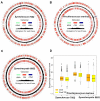Full transcription of the chloroplast genome in photosynthetic eukaryotes
- PMID: 27456469
- PMCID: PMC4960489
- DOI: 10.1038/srep30135
Full transcription of the chloroplast genome in photosynthetic eukaryotes
Abstract
Prokaryotes possess a simple genome transcription system that is different from that of eukaryotes. In chloroplasts (plastids), it is believed that the prokaryotic gene transcription features govern genome transcription. However, the polycistronic operon transcription model cannot account for all the chloroplast genome (plastome) transcription products at whole-genome level, especially regarding various RNA isoforms. By systematically analyzing transcriptomes of plastids of algae and higher plants, and cyanobacteria, we find that the entire plastome is transcribed in photosynthetic green plants, and that this pattern originated from prokaryotic cyanobacteria - ancestor of the chloroplast genomes that diverged about 1 billion years ago. We propose a multiple arrangement transcription model that multiple transcription initiations and terminations combine haphazardly to accomplish the genome transcription followed by subsequent RNA processing events, which explains the full chloroplast genome transcription phenomenon and numerous functional and/or aberrant pre-RNAs. Our findings indicate a complex prokaryotic genome regulation when processing primary transcripts.
Figures








Similar articles
-
Early photosynthetic eukaryotes inhabited low-salinity habitats.Proc Natl Acad Sci U S A. 2017 Sep 12;114(37):E7737-E7745. doi: 10.1073/pnas.1620089114. Epub 2017 Aug 14. Proc Natl Acad Sci U S A. 2017. PMID: 28808007 Free PMC article.
-
Reductive evolution of chloroplasts in non-photosynthetic plants, algae and protists.Curr Genet. 2018 Apr;64(2):365-387. doi: 10.1007/s00294-017-0761-0. Epub 2017 Oct 12. Curr Genet. 2018. PMID: 29026976 Review.
-
Plastid ndh genes in plant evolution.Plant Physiol Biochem. 2010 Aug;48(8):636-45. doi: 10.1016/j.plaphy.2010.04.009. Epub 2010 May 9. Plant Physiol Biochem. 2010. PMID: 20493721 Review.
-
Endosymbiosis: double-take on plastid origins.Curr Biol. 2006 Sep 5;16(17):R690-2. doi: 10.1016/j.cub.2006.08.006. Curr Biol. 2006. PMID: 16950094
-
Genomic reduction and evolution of novel genetic membranes and protein-targeting machinery in eukaryote-eukaryote chimaeras (meta-algae).Philos Trans R Soc Lond B Biol Sci. 2003 Jan 29;358(1429):109-33; discussion 133-4. doi: 10.1098/rstb.2002.1194. Philos Trans R Soc Lond B Biol Sci. 2003. PMID: 12594921 Free PMC article.
Cited by
-
Unraveling chloroplast transcriptomes with ChloroSeq, an organelle RNA-Seq bioinformatics pipeline.Brief Bioinform. 2017 Nov 1;18(6):1012-1016. doi: 10.1093/bib/bbw088. Brief Bioinform. 2017. PMID: 27677960 Free PMC article.
-
The Genome and Transcriptome Analysis of the Vigna mungo Chloroplast.Plants (Basel). 2020 Sep 21;9(9):1247. doi: 10.3390/plants9091247. Plants (Basel). 2020. PMID: 32967378 Free PMC article.
-
Araucaria angustifolia chloroplast genome sequence and its relation to other Araucariaceae.Genet Mol Biol. 2019 Jul-Sep;42(3):671-676. doi: 10.1590/1678-4685-GMB-2018-0213. Epub 2019 Nov 14. Genet Mol Biol. 2019. PMID: 31188933 Free PMC article.
-
Noncoding RNA: An Insight into Chloroplast and Mitochondrial Gene Expressions.Life (Basel). 2021 Jan 13;11(1):49. doi: 10.3390/life11010049. Life (Basel). 2021. PMID: 33450961 Free PMC article. Review.
-
Disentangling Sources of Gene Tree Discordance in Phylogenomic Data Sets: Testing Ancient Hybridizations in Amaranthaceae s.l.Syst Biol. 2021 Feb 10;70(2):219-235. doi: 10.1093/sysbio/syaa066. Syst Biol. 2021. PMID: 32785686 Free PMC article.
References
Publication types
MeSH terms
LinkOut - more resources
Full Text Sources
Other Literature Sources
Molecular Biology Databases

